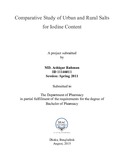Comparative study of urban and rural salts for iodine content.

View/Open
Date
2015-08Publisher
BRAC UniversityAuthor
Rahman, Md. AshiqurMetadata
Show full item recordAbstract
From the 18th century to till now the most notorious widespread public health crisis is iodine deficiency. Using iodized salt is the most effective strategy to fight against it. This paper is all about to assess the iodine concentration in available different branded and open salts from different rural and urban areas of Bangladesh. To measure the iodine level in salt samples, iodometric titration was used. The results show positive indication towards achieving our most desired goal of eliminating iodine deficiency disorders (IDD) from the country. Almost every branded salt sample contains iodine in the accepted range (minimum 20 ppm in consumption level and 50 ppm in production level). However, all the open salt samples showed poor iodine concentration (<5ppm). This indicates a large percentage of rural people are still in the risk of IDD only because of using these poorly iodized or non-iodized open salts. Government has achieved enormous success towards their goal of eliminating IDD particularly from urban areas of Bangladesh. Rural people are needed to make aware of using adequately iodized packet salts instead of poorly iodized or non-iodized open salts. Disseminating the consequences of iodine deficiency &benefits of using adequately iodized packet salts, re-pricing of packet salts considering the economic condition of rural people can be the only and effective strategy to boost up the usage of adequately iodized salts throughout the country.
Keywords: - Iodine deficiency disorders, open salts.
